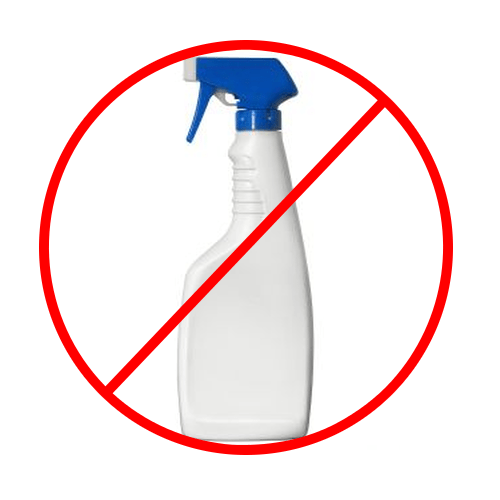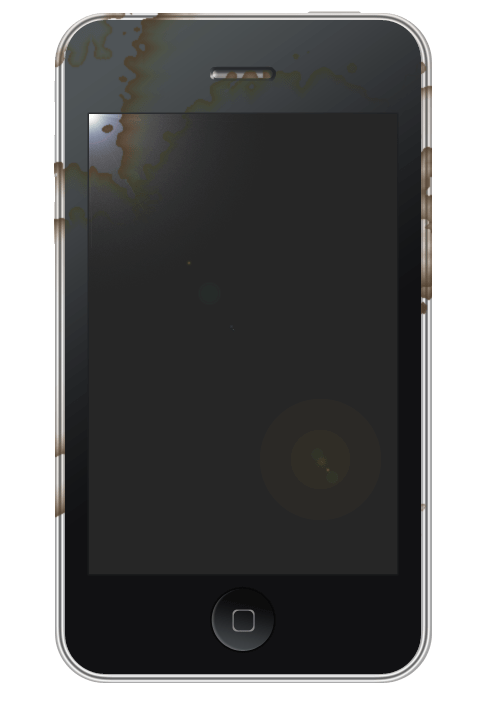
February 24, 2022 at 9:37 p.m.
With normal use, your iPhone will build up fingerprints and smudges. This article will show you how to safely clean your iPhone, iPad or iPod Touch.
Never Use Detergents
The iPhone is rugged but also delicate in some respects. The touch screen, in particular, is sensitive and should never been cleaned with any detergent or cleaning product. Using a detergent or cleaner on an iPhone will eventually damage the screen’s oleophobic coating. You may be tempted to use eyeglass wipes, as they claim to be safe for electronic devices and lenses. They’re not safe for touch screens. Don’t use them.
Normal iPhone Cleaning
Your device should be cleaned regularly to remove the accumulation of natural oils and finger prints. Apple recommends using a soft, slightly damp, lint-free cloth. The problem with most cloth is that it is somewhat abrasive and will eventually damage the screen coating. Regular cloth also tends to keep dirt on the surface of its fibers. This dust and dirt can act as an abrasive.
The best way to clean your iPhone is with a microfiber cloth. Microfiber is a special material composed of split fibers. These split fibers trap dust and dirt so they don’t scratch the surface that is being cleaned. The top image shows microfiber and the bottom image shows cotton fiber. Notice how the microfiber traps dirt:
Microfiber cloths are sold at optometry practices, as they are often used to clean eyeglasses without scratching them or wearing away anti-reflective coatings. You can also purchase these from online retailers and in some stores. Microfiber cloths are inexpensive and washable.
If you wear eyeglasses, you know why microfiber cloth is better than any ordinary cloth. Cleaning eyeglasses with your shirt or a handkerchief will eventually scratch them. If you use any piece of cloth to clean your iPhone, you could damage the oleophobic coating or touch screen. Eventually this will lead to scratches on the screen. According to Apple: “The ability of this coating to repel oil will diminish over time with normal use, and rubbing the screen with an abrasive material will further diminish its effect and may scratch the glass.”
If you have an older iPhone or an iPhone SE, the Touch ID-enabled home button is also sensitive, which is all the more reason to invest in microfiber cloths. Some users have complained about flaws in Touch ID. For the most part, proper cleaning of the Touch ID surface fixes most issues.
Always clean your device over a soft surface, such as a bed. When you are cleaning your device, it’s easy to let it slip out of your hands. If you are doing this standing up, your iPhone could drop a few feet, perhaps onto a hard floor. A drop like that, even on carpeting, could damage your device. If you clean your iPhone over your bed, accidentally dropping the device won’t result in damage.
Don’t clean your iPhone obsessively. It’s OK to have some fingerprint smudges. If you clean your iPhone constantly, even with a microfiber cloth, it will wear down the oleophobic coating faster.
How to Clean a Soiled iPhone
If your iPhone has become soiled with something beyond fingerprints and natural oils, you should still avoid using detergents and cleaners. Use a slightly damp microfiber cloth. With a little effort, you should be able to remove the dirt. If you spilled something on your iPhone, follow these steps to fix it.
How to Safely Sanitize an iPhone
Those who wish to avoid illness may attempt sanitizing their iPhone with isopropyl alcohol or other anti-microbial agents. While one can accomplish this safely without compromising the iPhone’s fingerprint-resistant oleophobic coating, it’s essential to use the appropriate cleaning agent in a safe yet effective concentration.
Apple’s website provides information about cleaning an iPhone with more potent agents, such as isopropyl alcohol, ethyl alcohol, or Clorox wipes. According to Apple, one can safely sanitize an iPhone with a 70% isopropyl alcohol wipe, a 75% ethyl alcohol wipe, or Clorox wipes.
Apple neglects to mention that many wipes contain aloe and other plant-based extracts to moisten and nourish the skin. Make sure to avoid these wipes, as they tend to leave a residue on devices. They’re designed for cleaning human skin, not gadgets. Purchase wipes intended for cleaning devices or clinical purposes (antiseptic).
Ideally, a solution of greater than 60% of either type of alcohol is needed to kill microbes effectively. However, the action of wiping a solvent-dampened microfiber cloth can remove microbes without high concentrations of alcohol that could damage your device. Think of this as an option if your device isn’t heavily soiled. If you drop your iPhone onto a plate of raw chicken, you should opt for something more substantial.
Ethyl alcohol is the easiest to obtain, as it’s probably right in your liquor cabinet. Vodka only has 40% ethyl alcohol, so it’s safer than most wipes. Make sure to apply just enough spirits to dampen the microfiber cloth. Again, with this lower concentration of alcohol, it’s best for lightly soiled devices. Also, it’s best to stick with vodka and avoid brown liquors such as bourbon or scotch. Vodka is essentially pure ethyl alcohol diluted with water.
Zeiss lens wipes are another excellent option for gently cleaning a lightly contaminated iPhone. With only 40-50% isopropyl alcohol, the wipes are so safe that they won’t even remove anti-reflective coatings from eyeglasses. I’ve used these wipes for over a decade on glasses, iPhones, iPads, and laptops. They clean effectively and don’t leave streaks or lint.
If your iPhone is heavily soiled or contaminated, electronics wipes intended for flat-screen TVs are an excellent option. I rarely use these on my iPhone simply because it doesn’t get that dirty. But my laptop gets a bit grungy where my palms meet the deck, so I wipe it down about once in two weeks. Although these wipes are intended for flat-screen TVs, they left a haze on my Sony Bravia, which is over 15 years old. Nonetheless, if you dropped your iPhone in a dirty toilet, these will clean it up. The kit comes with a microfiber cloth to finish the job without streaks or lint.
Prevent Your iPhone From Getting Dirty
It’s a good idea to prevent your iPhone from getting dirty. Avoid using your iPhone with dirty or greasy fingers. Of course, if you wash your hands often, they will build up a residue of soap, which could also harm your iPhone.
You don’t need to over think this. Just use common sense. Don’t eat a bowl of buttered popcorn and smear grease on your iPhone. Just wipe your hands with a napkin before using it. Don’t apply hand lotion and then smear it all over your iPhone. It’s not designed to repel these types of oils. Think of it this way — instead of wiping off your iPhone, wiping off your fingers may also keep your device clean, without wearing down the oleophobic coating.
There are also cases designed protect your iPhone from virtually everything, including dirt and fingerprints. Some cases enable use of the touch screen while the device is completely encased. These are a great solution if you need to bring your iPhone into a messy environment.
Plastic Wrap Provides Temporary Protection for the iPhone
Something as simple and inexpensive as plastic wrap can serve as makeshift protection for your phone. Just make sure not to wrap your iPhone with too many layers of plastic wrap, as this could compromise touchscreen sensitivity.
Temporarily covering your iPhone with plastic wrap can protect your device from dust, dirt, and even microbes like viruses and bacteria. If you’re cooking and using your iPhone, covering it with plastic wrap can prevent it from getting splattered with hot grease, water, or other substances.
A plastic bag can also provide similar protection; however, operating the device may prove difficult. Plastic bags are also more costly than stretchy, transparent film. But if that’s all you have around the house, it’s a suitable option.
Beware of Bad Advice
The Internet is full of bad advice. When it comes to cleaning the iPhone, there’s an abundance of misinformation. For example, some advise using alcohol or ammonia based products (such as Windex) to clean the device. Don’t use any detergent or cleaning product, no matter how gentle the manufacturer claims it is. There are brands of eyeglass wipes with pictures of iPods on the box. Don’t use them to clean your iPhone. They usually have alcohol or some detergent that will eventually wear off the oleophobic coating. Even if they are safe for eyeglasses and camera lenses, keep in mind, the iPhone has an oleophobic coating. Cleaning products will hasten the demise of this coating.
Some of the bad advice pertains to cleaning specific parts of the iPhone. For example, some people advise taking apart your iPhone, dislodging the camera and blowing air into it to clean it off. It is highly unlikely that dirt will get inside the camera. If that has happened, take it to a professional, unless you know what you are doing or have nothing to lose. After all, your iPhone may be old and you may be up for a subsidized replacement. If you break it while attempting to fix or clean it, that’s not as bad a breaking a brand new iPhone.
There is more bad advice when it comes to cleaning the speakers. I even read that one should use hydrogen peroxide applied with an ear swab. Don’t do that. Just use a microfiber cloth.
The advice in this article will ensure that your iPhone, iPad or iPod Touch will last for years to come. I strongly encourage you to invest in microfiber cloths and take care when cleaning your iPhone. It’s also a good idea to wipe off soiled or greasy fingers before using your device. If your fingers are clean, your device will be clean, which will minimize wear on the oleophobic coating.





